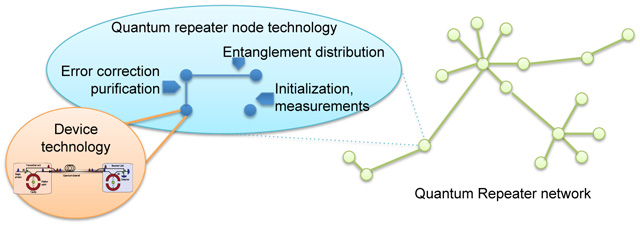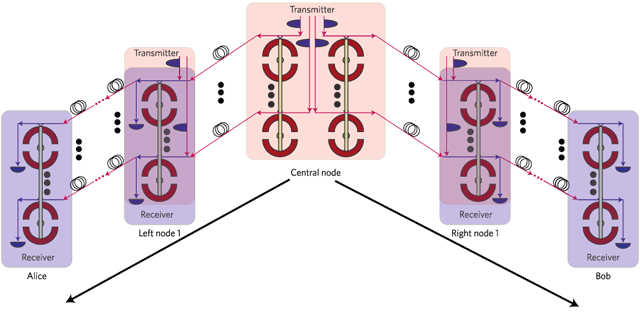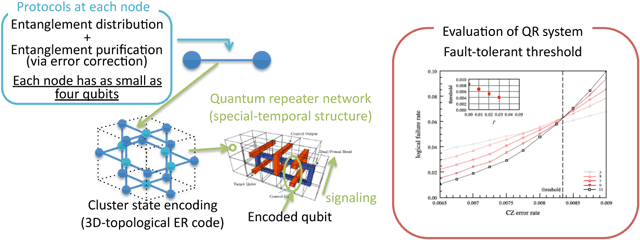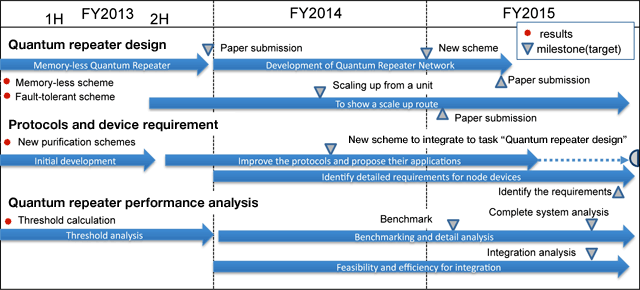
Subject A : Design and evaluation theory of quantum repeater
158A-T01System design of quantum repeater network and device evaluation
National Institute of Informatics (Kae Nemoto)
The quantum repeater is a core technology for future quantum communication. In this project, we focus on the system design and device requirements for scalable quantum repeaters. The target distance for quantum repeater systems in this project spans from 50km to 3000km, which will be sufficient to cover a city to the whole country. We investigate system designs applicable to arbitrary networks to be applied to different geometrical structure. These network system designs will be then define the quantum repeater node technology. In the node technology development, protocols need to be identified to implement the system design, and the functions of devices have to be specified to run the protocols at each node. Finally the requirements for the building blocks will be detailed. With the integration of these technological layers, the performance analysis will be possible to compare different quantum repeater systems. The evaluation of the devices and systems with the integrated technology will give us a clear way forward for the future quantum repeater development.

Fig. 1
Subtheme and tasks:
- 1: Quantum repeater design
- a) Development of linear quantum repeater designs
- b) Development of quantum repeater network designs
- 2: Protocol and device requirements
- a) Protocol developments
- b) Requirements for quantum repeater networks
- 3: Quantum repeater performance analysis
- a) Performance analysis for linear quantum repeater design
- b) Quantum repeater system evaluation
- c) Feasibility for integration of different repeater systems
There are two major technological obstacles to implement the existing quantum repeater designs. In the first half of this project, we tackle these from different angles.
Interim results for Team 158A-T01
| Task title | Outcome | Date | Note |
|---|---|---|---|
| 1: Quantum repeater design | New memory-less quantum repeater design was developed. | Mar. 2013 | Nat. Photonics, 6, 777 (2012) |
| A fault-tolerant scheme with small resource was proposed. | Mar. 2013 | ||
| 2: Protocols and device requirements | Error correction protocols were tested in a quantum repeater design. | Mar. 2012 | |
| Error correction for memory-less scheme was developed. | Mar. 2013 | ||
| 3: Quantum repeater performance analysis | Fault-tolerant threshold was analyzed. | Mar. 2013 |
Quantum communication is bounded by the communication distance, and this indicates the necessity of quantum memory, which is still challenging with today's technology. To overcome this, we either develop long-lived quantum memory or realize an encoded memory to be error corrected. The fundamental question is whether quantum memory is essential for quantum repeater. We developed a memory-less quantum repeater to show that it is possible to design quantum repeater without quantum memory.

Fig. 2A schematic graph of the memory-less quantum repeater design
The second challenge is related to the physical resource required to implement quantum repeaters. The existing quantum repeater designs with usable communication rates require a large number of devices at each node. We have succeeded to dramatically reduce the resource. To do this, we employed error correction codes to operate both the error correction mode and the error detection mode. The error detection mode is very efficient for quantum repeater. We also combine quantum communication and computation to achieve a new fault-tolerant quantum communication with a relatively small resource.

Fig. 3
Target for Team 158A-T01
| Task title | Work/Milestone | Due Date | Note |
|---|---|---|---|
| 1: Quantum repeater design | a) Development of quantum repeater network with flexible resource allocation on demand | Oct. 2015 | |
| b) Show a scale up route from an unit to a system | Mar. 2016 | ||
| 2: Protocols and device requirements | a) Improve the protocols and propose their applications | Oct. 2015 | |
| b) Identify detailed requirements for node devices | Mar. 2016 | ||
| 3: Quantum repeater performance analysis | a) Benchmark for system performance for linear quantum repeater designs to achieve communication rates 1kHz and 1MHz. | Oct. 2015 | |
| b) Detailed analysis for scalability, resources, and communication rates. | Mar. 2016 | ||
| c) Feasibility and efficiency for integration of systems based on different technology | Mar. 2016 |

Chart 1Schedule for Team 158A-T01